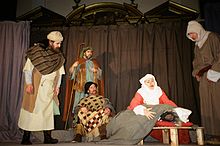| The Second Shepherds' Play | |
|---|---|
 The shepherds realise that the babe in the cradle is actually a sheep. Players of St Peter, London (2005). | |
| Written by | The Wakefield Master |
| Characters |
|
| Date premiered | Unknown (possibly c. 1500) |
| Place premiered | England |
| Original language | Middle English |
| Series | Wakefield Cycle |
| Genre | Mystery Play |
| Setting | Medieval England and Bethlehem 1st Century AD |
The Second Shepherds' Play (also known as The Second Shepherds' Pageant) is a famous medieval mystery play which is contained in the manuscript HM1, the unique manuscript of the Wakefield Cycle. These plays are also referred to as the Towneley Plays, on account of the manuscript residing at Towneley Hall. The plays within the manuscript roughly follow the chronology of the Bible and so were believed to be a cycle, which is now considered not to be the case.[1] This play gained its name because in the manuscript it immediately follows another nativity play involving the shepherds. In fact, it has been hypothesized that the second play is a revision of the first.[2] It appears that the two shepherd plays were not intended to be performed together since many of the themes and ideas of the first play carry over to the second one.[3] In both plays it becomes clear that Christ is coming to Earth to redeem the world from its sins. Although the underlying tone of The Second Shepherd's Play is serious, many of the antics that occur among the shepherds are extremely farcical in nature.
- ^ Black, Joseph; et al. (2012). The Broadview Anthology of British Literature, Concise Edition, Volume A, Second Edition. Canada: Broadview Press.
- ^ Robinson, J. W. (1991). Studies in Fifteenth-century Stagecraft. Kalamazoo: Western Michigan University Medieval Institute. ISBN 0918720389.
- ^ Abate, Michelle Ann (2005). "Oversight as Insight: Reading The Second Shepherds' Play as The Second Shepherd's Play". Early Theatre. Literature Resource Center. doi:10.12745/et.8.1.694. Retrieved 17 July 2012.